Kingfishers Out Loud
August marks the coming deadline for delivering my new book manuscript to Chelsea Green Publishing. That leaves little space for writing new blogs. Since summer can be a dreamy time to read outdoors in a hammock or listen to audiobooks on long-distance treks, I’m highlighting my narration of the introduction to Halcyon Journey, In Search of the Belted Kingfisher, as recorded by my talented neighbor Michael Kellogg. For those who haven’t yet read my book, illustrated by Ram Papish, I hope this teaser might tempt you to give it a try. Pick up a copy from your library (ask them to order if they don’t have it yet). Buy the paperback online or in local bookstores. The latest print run showcases the 2024 John Burroughs Medal on the cover and lists the National Outdoor Book Award and Foreword Indies Award inside. You can also listen to the audiobook (narrated by Lisa Ware). I’d also be grateful for additional reviews on Amazon and Goodreads. Thank you.
As far as Belted Kingfishers in the wilds right now, the young have fledged from their burrows and sometimes stick together as they develop their skills. Listen for the rattling, chattering, cheery calls of the birds of halcyon days whenever you are by their watery haunts. They are narrating the news of flowing waters, from beavers slapping tails to swallows flocking before they head south.
Click below to hear me reading the introduction.
BOOK EXCERPT, HALCYON JOURNEY IN SEARCH OF THE BELTED KINGFISHER, BY MARINA RICHIE AND PUBLISHED BY OREGON STATE UNIVERSITY PRESS
INTRODUCTION
Some journeys are meant to be hard. Belted kingfishers are loners, territorial, and wary. They are fiendish to study. Yet, a difficult quest promises both allure and reward. The heartbeat of this story pulses along Rattlesnake Creek in Missoula, Montana, where a pair of kingfishers still court, nest, and tend their young to the music of rollicking currents. Over the course of seven years, from spring 2008 through the summer of 2015, I followed with curiosity as the birds continued to baffle, elude, and enlighten.
In certain tribal stories, the belted kingfisher is a messenger, helper, or protector. To tap into those powers takes more than one season. Each year, I recorded behaviors in the company of naturalist friends. By the forested creek’s edge, I would find the convergence of Greek and indigenous myths, kinship with wild inhabitants, and personal transformation.
Traveling far to investigate clues to the mystery of why the female is more colorful than the male, I met several members of the greater family, from the ringed kingfisher on the Mexico border to the giant kingfisher in South Africa. Seeking the dazzling bird of Greek myth, I prowled Hampstead Heath in London and found the common kingfisher in a dreamlike setting.
On the east coast, I pulled out trays of study skins in an eerie back room of the Smithsonian, paddled below hovering belted kingfishers in a North Carolina bay, and sought wintering birds by Chincoteague National Wildlife Refuge over the solstice. Returning to Rattlesnake Creek, I opened my eyes anew to one species on a small stretch of stream in the context of an interwoven planet.
Flying with practiced ease above North America’s streams, rivers, lakes, ponds, and coastlines, belted kingfishers are the supreme avian anglers. They may be only a tad bigger than robins, but their beaks are blades, and their obsidian eyes miss nothing.
Whether hovering or diving from a branch, a kingfisher’s headfirst plunge to snap fish near the surface is swift and precise. Touching down by cities, towns, farms, and wilderness alike, belted kingfishers flourish only where water is clean, in places with plentiful fish, perches, and coveted earthen nest banks. Even their plumage matches the sheens of water and stone—dusky blues, grays, whites, and, for the female, a dash of cinnamony red to form the namesake belt.
In the first days of my pivotal decision to track the kingfisher, on a windy spring afternoon beneath Bozeman’s Bridger Range, cheering for my son’s team from the soccer field sidelines, I’d confided to a fellow parent: I’d made a discovery—a revelation that added a mythic appeal to an already charismatic bird.
“Cool, you’ve found the feel-good bird!” the parent said, with that knack he had for clinching the spare phrase, a skill he applied to his prose and a side job of pruning trees, lopping off limbs with editorial precision.
Those prescient words would ring true in ways I had not considered. Like the elusive quality of idyllic halcyon days, the secretive nature of kingfishers would prove instrumental to my happiness. Running, stumbling, tangling through wild rose and hawthorns, shivering, and staying put for hours, I’d savor every hard-fought glimpse. A surge of feeling good resulted from tenacity, like a marathoner crossing a finish line, another personal goal I finally achieved in September of 2015.
That’s one kind of feeling good. Another stemmed from immersion in my home creek with the kingfisher as a guide. Dabbling toes in the frigid wilderness-fed waters, my senses awakened to the syncopated glugs, sprays, froths, and singing of an enlivened stream.
Hiding in a camouflaged blind, I merged with the alders, cottonwoods, and pines. When a Swainson’s thrush landed within grasp and opened his beak to sing, I nodded to yet another sign of my bird-loving father’s presence, as if we could still revel in the soloist poet of the wafting, spiraling-away verse. In the company of creekside inhabitants, sorrows and losses cascaded into the clear waters where bull trout finned upstream to spawn.
In the intervening years, I’ve integrated new science, more indigenous stories, and insights gained from reflection and observations, including one memorable evening on the Oregon coast. As golden sun rays lapped upon a sandstone outcrop that stood between me and a vigilant kingfisher, the receding high tide yielded just enough room to edge around the corner within view of a nest hole excavated by the diligent parents. One cautious step at a time, I ducked below leathery green leaves of a salal bush. In my black down jacket, gray pants, and rubber boots, I hoped to blend in like a cormorant. Instead, I faced the full fury of an indignant queen fisher. Her crown was a feathery two-part crest, her throne a lichen-draped branch, and her decree a volley of reproving notes.
I gazed with longing at the burnished coppery red belt on a moon-white chest and yearned to plead my case: “I’m your subject. I will stay right here and fasten myself to this sandstone cliff like a barnacle. I won’t be in your way.”
But no. She breezed off to cross the bay that opened to the Pacific. I backed away into the linger of light, leaving the nesting kingfishers in peace.
Listening to National Public Radio in June of 2021, I heard the Pulitzer Prize–winning poet Yusef Komunyakaa describe his calling: “It feels like one has been chosen as a caretaker of observation.”
For all who witness the intricacies of nature, we are the caretakers of observation, too. As the climate and extinction crises accelerate, the clarion notes of kingfishers convey a ratcheting up of urgency. With care comes responsibility to act on behalf of all forms of life that cannot speak for themselves.
My offering here is at once an ode to the halcyon bird and a call for protection of their watery homes, from headwater springs to ocean confluences and all the interconnected wilds, from ancient forests to wildflower meadows and beaver-created marshes.
Since making the pivotal choice to trail a tricky bird with a flair for fishing, I’ve learned much, during what has become a lifelong apprenticeship. Seeking kingfishers near rippling or tranquil waters, worries tend to mist away.
Living now in Bend, Oregon, I listen for the reverberating notes that ricochet across the jade green currents of the Deschutes River in a mellifluent staccato always taking me home. Veering quick and low to the sun-sparkled whitewater, a kingfisher flicks droplets with pointed wingtips. Star spreader. Joy splasher.
A sampling of Ram Papish’s illustrations below:









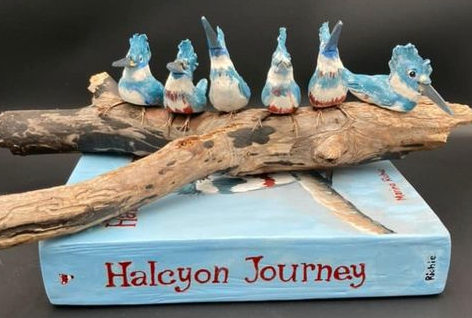
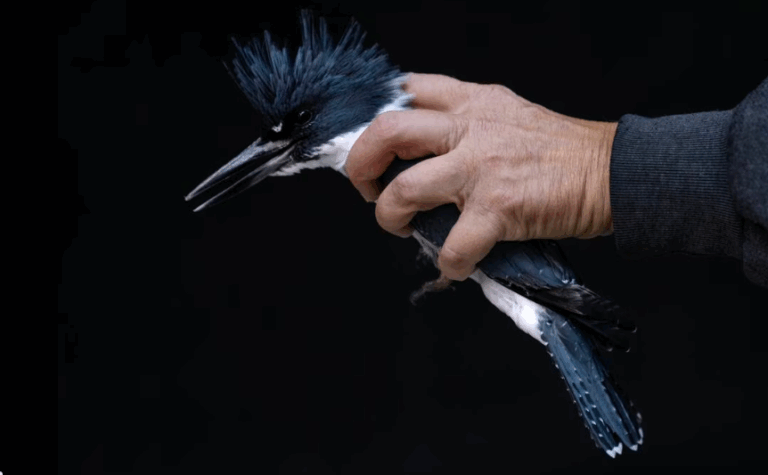
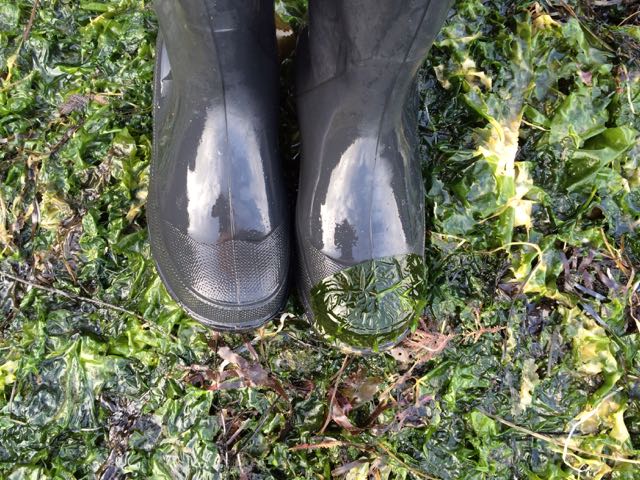
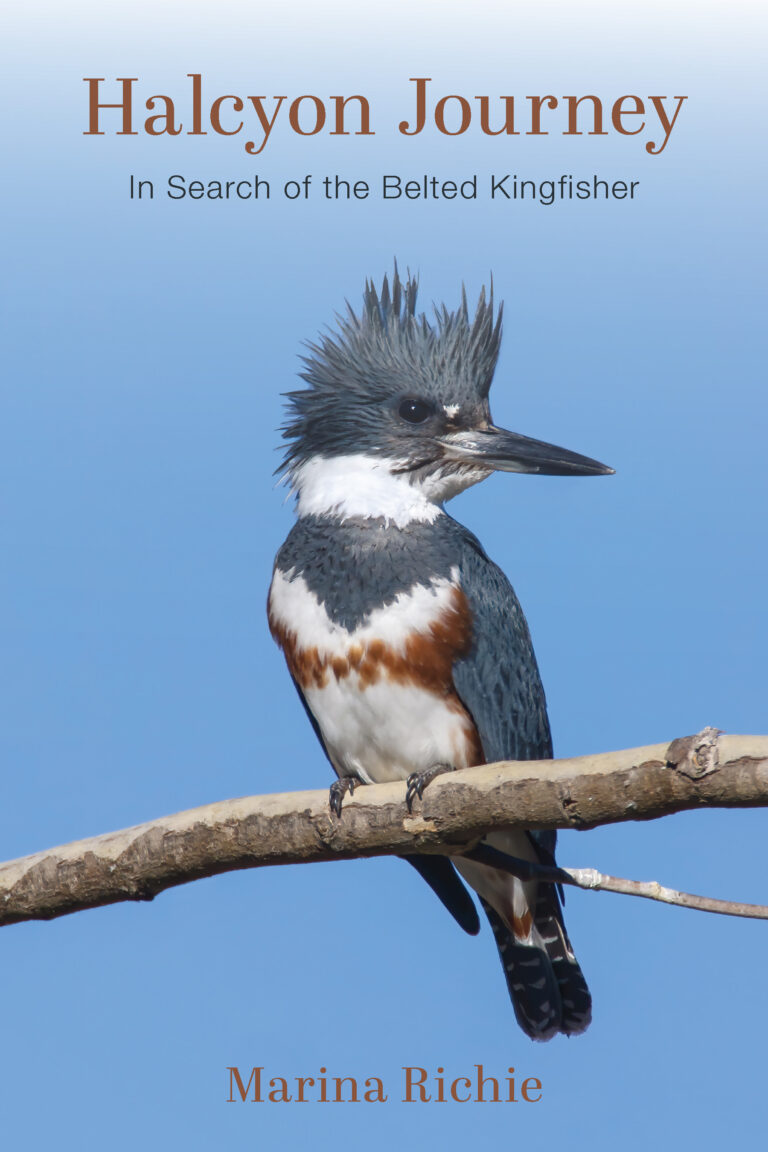

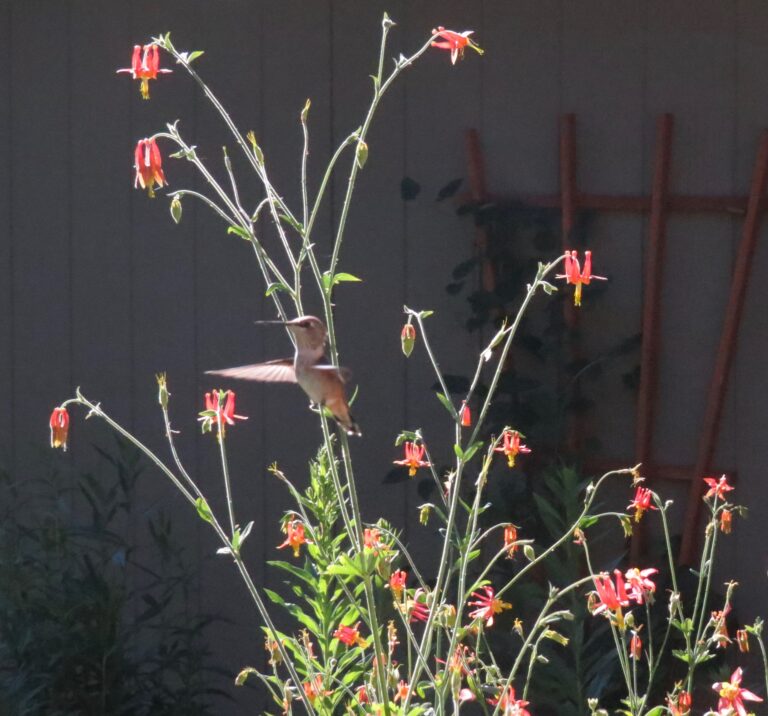
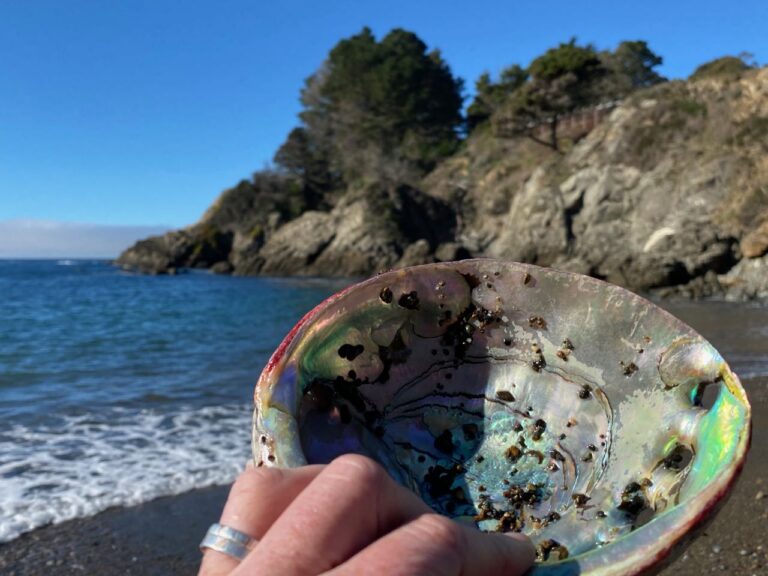
I absolutely loved this book, Marina. Your poetic prose brings the natural world into the realms of we “city girls.” Thank you so much for your words in the world. xoA
Thank you Annis– I love that! Can I quote you as praise for the book? I’m so happy Halcyon Journey reaches city girls too.
Yes, go ahead and use it. But please correct to say “us city girls.” Thanks! ♥️
Hey Friend Marina:
Judging by the arrival of this latest blog, we’re definitely still on the same page, as I’ve been writing about one of the many summer sleep-overs I did with my friend, Doug, at their log home on China Creek, where it empties into the N. Fk. Burnt River. As you can imagine, most of our summer days were in or near the waters of the River. Belted Kingfishers fast became my favorite smaller (next to the bigger red-tailed hawk) as they swooped and dove into the waters of the cut-off meanders. Your pics and verbal descriptions of the kingfishers immediately propel me back to those long-ago summer scenes…thanks you!
Friend, Mike
Thanks Mike for sharing that description of kingfishers by the North Fork Burnt River–they definitely like the meanders and oxbows for fishing. I’m so glad you are writing down those memories.
4:30 a.m….Do you ever sleep???
Friend, Mike